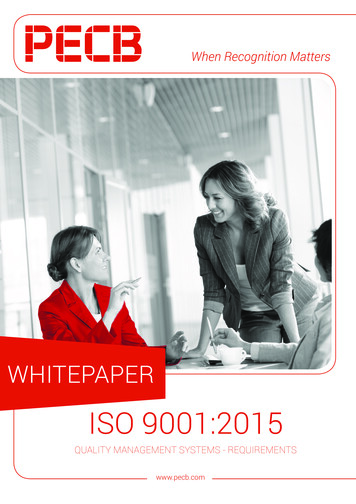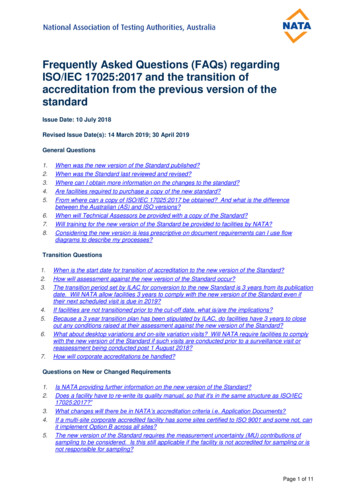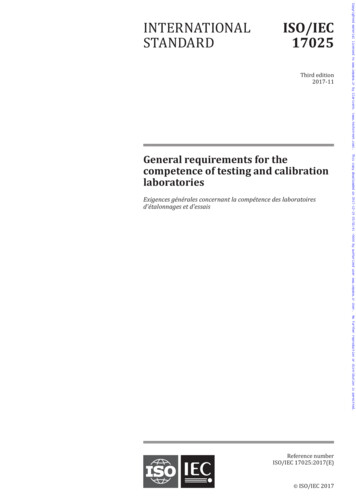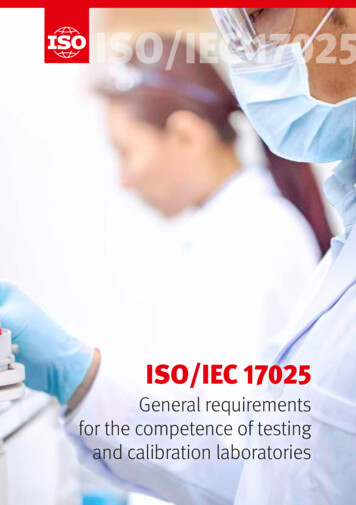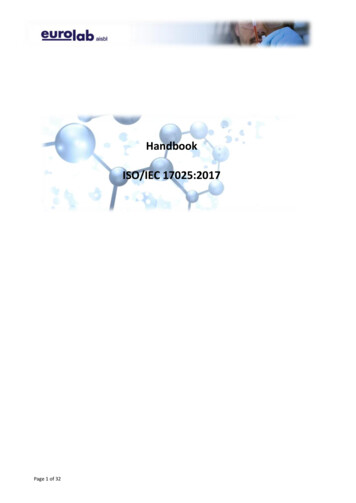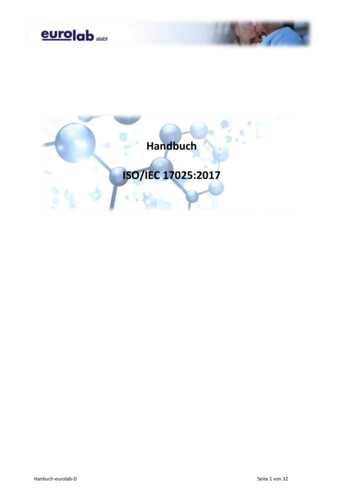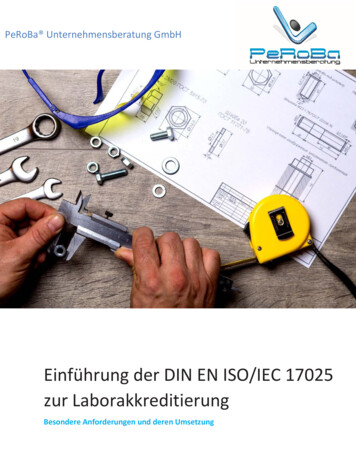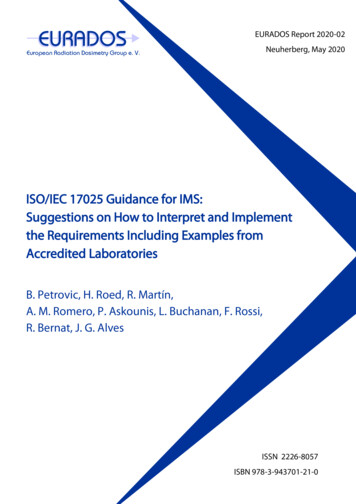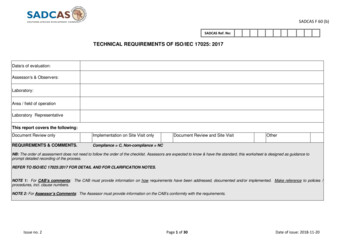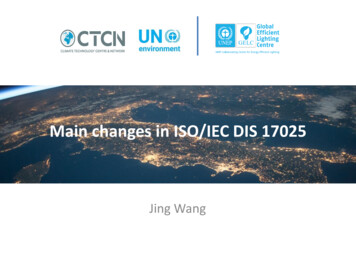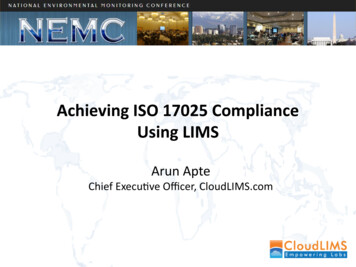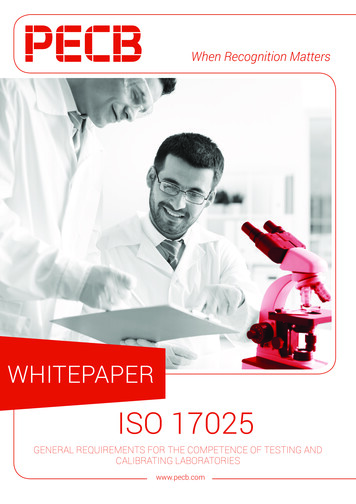
Transcription
When Recognition MattersWHITEPAPERISO 17025GENERAL REQUIREMENTS FOR THE COMPETENCE OF TESTING ANDCALIBRATING LABORATORIESwww.pecb.com
CONTENT3Introduction4An Overview of ISO 17025:20054Key Clauses of ISO 17025:20057ISO 17025 opposed to ISO 90017The Business Benefits of Laboratory Management7Why is PECB a Worthy Choice?9Steps for obtaining a PECB CertificationPRINCIPAL AUTHORSEric LACHAPELLE, PECBBesnik HUNDOZI, PECB2ISO 17025 // GENERAL REQUIREMENTS FOR THE COMPETENCE OF TESTING AND CALIBRATION LABORATORIES
INTRODUCTIONLaboratories have to continuously provide high-quality services if they tend to be successful in the marketplace.Using the ISO 17025 standard will assure quality improvement and consistency in an organization.ISO 17025 is the only internationally accepted standard for laboratory quality systems that provides aglobally accepted basis for accreditation. The first version (ISO Guide 25) of this standard was published in1999, by the International Organization for Standardization (ISO).The second version was released in 2005,which is more aligned with the ISO 9001:2000 standard regarding quality system words.ISO 17025:2005 specifies the general requirements a laboratory has to meet if it is to be recognized ascompetent to carry out tests and/or calibrations, including sampling. It covers testing and calibrationperformed using standardized methods, methods not covered by standardized methods, and laboratorydeveloped methods.However, compliance with regulatory and safety requirements on the operation of laboratories is notcovered by ISO 17025:2005.If a laboratory wishes accreditation for part or all of its testing and calibration activities, it should select anaccreditation body that operates in accordance with ISO/IEC 17011 (General requirements for accreditationbodies accrediting conformity assessment bodies).ISO 17025 // GENERAL REQUIREMENTS FOR THE COMPETENCE OF TESTING AND CALIBRATION LABORATORIES3
AN OVERVIEW OF ISO 17025ISO/IEC 17025 is the global quality standard for testing and calibration laboratories. It is the basis foraccreditation from an accreditation body.This International Standard is applicable to all organizations performing tests and/or calibrations regardlessof the number of personnel or the extent of the scope of testing and/or calibration activities. These includefirst-, second- and third-party laboratories, and laboratories where testing and/or calibration forms part ofinspection and product certification.There are two main clauses in ISO/IEC 17025:1. Management requirements – which relate to the operation andeffectiveness of the quality management system within the laboratory.2. Technical requirements - which address the competence of staff;testing methodology; equipment and quality; and reporting of test andcalibration results.What is a Laboratory?A laboratory is an organization thatperforms tests and/or calibrations ina permanent, temporary, or remotelocation.ISO 17025 applies to organizations performing tests and/or calibrations that wish to:1. Establish, implement and maintain laboratory management system;2. Assure conformity with the laboratories stated quality policy;3. Demonstrate conformity to others;4. Seek accreditation of its laboratory by an accreditation body; and5. Make a self-determination and self-declaration of conformity with this International Standard.This international standard is for use by laboratories in developing their management system for quality,administrative and technical operations.It can also be used by laboratory customers, regulatory authorities and accreditation bodies to confirm orrecognize the competence of laboratories.What is Testing?It is the determination of one or more characteristics of an object of conformity assessment,according to a procedure.What is Calibration?It is an operation that, under specified conditions, in a first step, establishes a relation betweenthe quantity values with measurement uncertainties provided by measurement standardsand corresponding indications with associated measurement uncertainties and, in a secondstep, uses this information to establish a relation for obtaining a measurement result from anindication.KEY CLAUSES OF ISO 17025:2005ISO 17025 is organized into the following main clauses:Clause 4: Management RequirementsClause 5: Technical RequirementsEach of these key activities is overviewed below.4ISO 17025 // GENERAL REQUIREMENTS FOR THE COMPETENCE OF TESTING AND CALIBRATION LABORATORIES
CLAUSE 4: MANAGEMENT REQUIREMENTSManagement requirements relate to the operation and effectiveness of the quality management system withinthe laboratory.Organization –The roles and responsibilities of the laboratory, the management and key personnel are defined.Management system – The laboratory management system shall be properly implemented, maintained andimproved based on the ISO 17025 requirements.Document control – All documents that are part of the management system are identified, created, approved,issued and changed according to procedures.Review of requests, tenders and contracts – The requirements for requests, tenders and contracts are defined,documented and understood.Subcontracting of tests and calibrations – This sub-clause describe how to ensure that subcontracting testsand/or calibrations are performed by competent subcontractors.Purchasing services and supplies – Management shall ensure that purchased services and supplies do notaffect the quality of test and/or calibrations.Service to the customers – The laboratory shall continually meet customer requirements.Complaints – All complaints received are documented, evaluated and followed up.Control of nonconforming testing and/or calibration work – Nonconforming test and calibration results arefollowed up and corrected.Improvement – The effectiveness of the laboratory management system is continually improved.Corrective action – The root cause of nonconformities are identified and adequate corrective actions areselected, implemented, documented and monitored.Preventive action – Preventive actions shall be initiated when potential sources of nonconformities have beenidentified.Control of records – Records are identified, available when needed, and protected against unauthorized access.Internal audits – The laboratory shall conduct internal audits periodically to verify compliance with therequirements of the management system and ISO 17025.Management review – Management reviews shall be conducted to ensure suitability and effectiveness of themanagement system and testing and/or calibration activities.Clause 5: Technical RequirementsTechnical requirements relate to the competence of staff, sampling and testing methodology, equipmentand the quality and reporting of test and calibration results.Personnel – All laboratory personnel that have the highest impact on test and calibration results areadequately competent.Accommodation and environmental conditions – The laboratory shall ensure that the facilities for testingand/or calibration do not invalidate results or adversely affect the quality.ISO 17025 // GENERAL REQUIREMENTS FOR THE COMPETENCE OF TESTING AND CALIBRATION LABORATORIES5
Test and calibration methods and method validation – Appropriate methods for test and/or calibrationsshall be used to ensure accuracy in results.Equipment – The laboratory shall use appropriate and properly maintained equipment for the correctperformance of tests and/or calibrations.Measurement traceability – All measurements shall be traceable to the International System of Units (SI).Sampling – The laboratory shall implement sampling procedures to ensure that statistically relevantrepresentative samples are taken and documented.Handling of test and calibration items – The laboratory shall protect the integrity of test and/or calibrationitems during transportation, receipt, handling, storage, retention and/or disposal.Assuring the quality of test and calibration results – The laboratory shall continually ensure the quality of results.Reporting of results – Obtained results shall be properly reported by ensuring clarity and accuracy.ISO 17025 OPPOSED TO ISO 9001Both standards have similar requirements included in their management systems.ISO 9001 is a standard that specifies requirements for a quality management system. It applies to companiesdesigning, manufacturing, servicing, calibrating and testing.Meanwhile, besides the fact that ISO 17025 provides the requirements for a management system, it alsodelivers technical requirements for laboratories performing testing and/or calibration services.THE BUSINESS BENEFITSMANAGEMENT SYSTEMOFALABORATORYAs with all major undertakings within an organization, it is essential to gain the backing and sponsorship ofexecutive management. By far the best way to achieve this, rather than through highlighting the negative aspectsof not having a laboratory management system is to illustrate the positive gains of having an effective qualitymanagement process in place.The adoption of an effective laboratory management process within an organization willhave many benefits in a number of areas: Increase of confidence in testing and/or calibration results;Better control of laboratory operations;Potential increase in business due to enhanced customer confidence and satisfaction;Improved reputation and image of the laboratory;National and international recognition;Continually improvement of quality and laboratory effectiveness; andRecognition of testing competence.WHY IS PECB A WORTHY CHOICE?Implementation of LMS with IMS2 methodologyConsidering the well documented benefits of implementing a Laboratory Management System based on ISO6ISO 17025 // GENERAL REQUIREMENTS FOR THE COMPETENCE OF TESTING AND CALIBRATION LABORATORIES
17025, makes the proposal easier to decide on.Most organizations now realize that it is not sufficient to implement a generic, “one size fits all” laboratorymanagement plan. For an effective response, with respect to maintaining the laboratory management system, sucha plan must be customized to fit to an organization. A more difficult task is the compilation of an implementationplan that balances the requirements of the standard, the business needs and the certification deadline.There is no single blueprint for implementing ISO 17025 that will work for every organization, but there are somecommon steps that will allow you to balance the frequent conflicting requirements and prepare you for a successfulcertification audit.PECB has developed a methodology (please see example below) for implementing a management system; the“Integrated Implementation Methodology for Management Systems and Standards (IMS2)”, and it is based onapplicable best practices. This methodology is based on the guidelines of ISO standards and also meets therequirements of ISO 17025.1. Plan2. Do1.1 Initiating the LMS2.1 Organizational Structure1.2 Understanding the organization2.2 Document Management1.3 Analyze the Existing System2.3 Design of Controls and Procedures1.4 Leadership and Project Approval2.4 Communication1.5 Scope2.5 Awareness and Training1.6 Policy2.6 Resource Management3. Check3.1 Monitoring, Measurement, Analysisand Evaluation4. Act4.1 Treatment of Non-conformities4.2 Continual Improvement3.2 Internal Audit3.3 Management Review2.7 Customer Management2.8 Operations ManagementMS2 is based on the PDCA cycle divided into four phases: Plan, Do, Check and Act. Each phase has between2 and 8 steps for a total of 18 steps. In turn, these steps are divided into 101 activities and tasks. ThisPractical Guide’ considers the key phases in your implementation project from start to finish and suggeststhe appropriate ‘best practice’ for each one, while directing your to further helpful resources as you embarkon your ISO 17025 journey.ISO 17025 // GENERAL REQUIREMENTS FOR THE COMPETENCE OF TESTING AND CALIBRATION LABORATORIES7
ProjectsCheckActThe sequence of steps can be changed (inversion, merge). For example, the implementation of themanagement procedure for documented information can be done before the understanding of theorganization. Many processes are iterative because of the need for progressive development throughoutthe implementation project; for example, communication and training.By following a structured and effective methodology, an organization can be sure it covers all minimumrequirements for the implementation of a management system. Whatever methodology used, theorganization must adapt it to its particular context (requirements, size of the organization, scope, objectives,etc.) and not apply it like a cookbook.8ISO 17025 // GENERAL REQUIREMENTS FOR THE COMPETENCE OF TESTING AND CALIBRATION LABORATORIES
STEPS FOR OBTAINING A PECB CERTIFICATIONFor organizations:For individuals:1. Implement the management system1. Participate in the training course2. Perform internal audit and reviews2. Register for the certification exam3. Select preferred certification body3. Sit for the certification exam4. Perform a pre-assessment audit (optional)4. Apply for the certification scheme uponsuccessful completion5. Perform the stage 1 audit5. Obtain certification6. Perform the stage 2 audit (on-site)7. Perform a follow-up audit (optional)8. Register the certification9. Assure continual improvement by conductingsurveillance auditsFor further details relating the types of trainings and certifications that PECB offers, please visit our website:www.pecb.comISO 17025 // GENERAL REQUIREMENTS FOR THE COMPETENCE OF TESTING AND CALIBRATION LABORATORIES9
1-844-426-7322customer@pecb.comCustomer Servicewww.pecb.com
ISO 17025:2005 specifiesthe general requirements a laboratory has to meet if it is to be recognized as competent to carry out tests and/or calibrations, including sampling. It covers testing and calibration performed using standardized methods, methods not covered by standardized methods, and laboratory-developed methods. However, compliance with regulatory and safety requirements on the .
